Getting to the Polling Place
Typical Issues
When parking is provided for voters, staff and volunteers, accessible parking must be provided for people with disabilities. Voters with disabilities who arrive by car need a parking space close to an accessible entrance. The accessible parking space has an adjacent access aisle that provides needed room for a person to open the car door fully and then stand with the aid of a walker, to transfer to a wheelchair, or to lower a wheelchair lift. The access aisle connects directly to an accessible route that leads to an accessible building entrance. In order to be usable, the access aisle must be relatively level, clear of gravel or mud, and the surface must be in good condition without wide cracks or broken pavement.
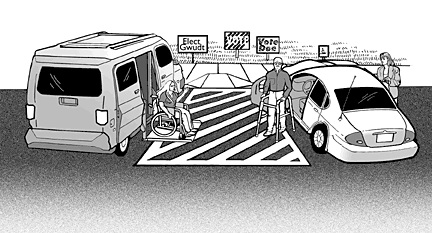
Van-accessible parking spaces serve both cars and vans. A wide access aisle is needed so a wheelchair lift may be lowered from the van onto the level surface.
An accessible route connects the access aisle of each accessible parking space with the accessible entrance to the polling place. When an accessible route crosses a curb, a curb ramp must be provided. If the accessible route connects the access aisle to the accessible entrance using the parking lot surface, a marked crosswalk should be provided on the vehicular route.
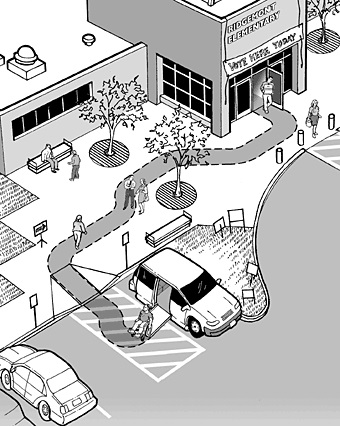
Parking Spaces Checklist
A1. If parking is available, count the total number of parking spaces provided for the polling place. Are the minimum number of accessible parking spaces provided, based on the total number of available parking spaces (see table below)?
Yes _____ No _____
| Total Spaces for Polling Place | Required Minimum Number of Accessible Spaces |
| 1-25 | 1 van-accessible space w/ min. 96 inch wide access aisle |
| 26-50 | 1 space w/ min. 60 inch wide access aisle + 1 van-accessible space |
| 51-75 | 2 spaces w/ min. 60 inch wide access aisle + 1 van-accessible space |
If more than 75, see the ADA Standards for Accessible Design, section 4.1.2, for the number of accessible parking spaces.
A2. Does each accessible parking space have its own, or share an adjacent access aisle that is least 60 inches (5 feet) wide? [ADA Stds 4.6.3]
Yes _____ No _____
A3. Is there at least one van-accessible parking space provided with an access aisle that is at least 96 inches (8 feet) wide or are universal parking spaces provided with a 132 inches (11feet) wide vehicle space and a 60 inch (5 feet) wide access aisle? [ADA Stds 4.1.2(5), A4.6]
Yes _____ No _____
A4. For van-accessible spaces, is there vertical clearance of at least 98 inches (8 feet - 2 inches) for the vehicle route to the parking space, the parking space, the access aisle and along the vehicle route to the exit? [ADA Stds 4.6.5] If No: Can the route be cleared by removing or raising low objects or can each van accessible parking space be relocated?
Yes _____ No _____

A5. Are all accessible parking spaces, including the access aisle, relatively level (1:50 or 2%) in all directions? [ADA Stds 4.6.3]
If No: Look for a nearby area that is relatively level which could serve as an accessible parking space with an accessible route to the accessible entrance to voting.
Yes _____ No _____
A6. Does each accessible parking space have a sign with the symbol of accessibility that is visible when a vehicle is parked in the space? [ADA Stds 4.6.4]
Yes _____ No _____
A7. If there is a curb between the access aisle and the accessible route to the building, is there a curb ramp that meets the following requirements: [ADA Stds 4.7]
a. Is the ramp surface at least 36” wide, excluding flared sides? [ADA Stds 4.7.3]
Yes _____ No _____
b. Is the slope (up or down the ramp) no more than 1:12? [ADA Stds 4.7.2] Note: 1:12 is one inch of vertical height for each 12 inches in length.
Yes _____ No _____
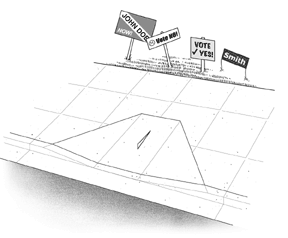
A8. Are the accessible parking spaces serving the voting area on the shortest accessible route to the accessible entrance? [ADA Stds 4.6.2]
Yes _____ No _____
A9. Does each access aisle connect to an accessible route from the parking area to the accessible building entrance? [ADA Stds 4.6.2]
Yes _____ No _____
Temporary Solutions for Election Day
Parking
Problem One:
Parking is available, but no accessible parking is provided or there are not enough accessible parking or van-accessible spaces.
Suggestion: Find a relatively level parking area near the accessible entrance and then designate the area for accessible parking spaces and adjacent access aisles. Use three parking spaces to make two accessible parking spaces with an access aisle. Traffic cones or other temporary elements may be used to mark the spaces and access aisles. Provide a sign designating each accessible parking space and make sure the access aisle of each space is connected to the accessible route to the accessible entrance.
Problem Two:
Accessible parking is provided, but it does not have a marked access aisle next to each accessible space.
Suggestion: Restripe the accessible parking spaces to provide an access aisle. As a temporary solution for election day, use traffic cones to mark off the access aisle and curb ramp area. The first accessible parking space provided should be a van accessible parking space with an access aisle that is at least 96 inches wide.
Problem Three:
Accessible parking spaces or access aisles are on a sloped surface.
Suggestion: Find a parking area that is close to the accessible entrance and more level. Provide accessible parking spaces and access aisles in that area. Make sure the accessible parking spaces connect to an accessible route to the entrance. Provide a sign designating each accessible parking space.
Problem Four:
No sign with the international symbol of accessibility is installed at each accessible parking space.
Suggestion: Provide a temporary sign in front of each accessible parking space.
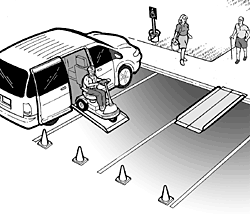
Three standard parking spaces are converted into an accessible parking space with an access aisle. Cones mark the access aisle and a temporary curb ramp with edge protection connects to an accessible route to the polling place.
Typical Issues
Some voters with disabilities will be driven to the polling place and dropped off near an entrance in a passenger drop-off area. If the polling place is served by passenger drop-off areas, then at least one drop-off area must be accessible. An accessible drop-off area, also known as an accessible passenger loading zone, must have a level access aisle, adjacent and parallel to the vehicle space. Where a curb separates the vehicle space from the access aisle or the access aisle from an accessible route, a curb ramp must be provided so people with disabilities can get to the accessible route leading to the accessible entrance.
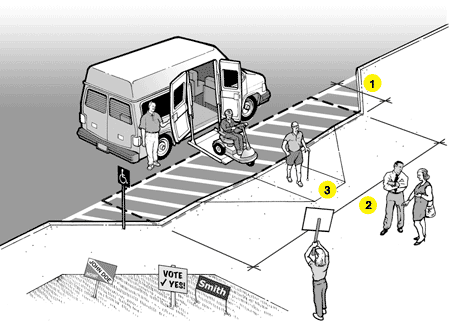
Accessible Passenger Drop-off and Loading Area
Notes:
1. Access aisle depth is at least 5 feet.
2. Access aisle length is at least 20 feet.
3. Curb ramp connects access aisle to the accessible route to the accessible entrance of the polling place.
The access aisle may be at the street level or at sidewalk level. If it is at the sidewalk level, a curb ramp is provided between the street and the sidewalk. If the access aisle is at the street level, the curb ramp is provided between the access aisle and the sidewalk (as shown).
Passenger Drop-Off Areas Checklist
If a passenger loading area is provided, you should answer the following questions.
B1. Is a relatively level (1:50 or 2% maximum slope in all directions) access aisle provided adjacent and parallel to the side of the vehicle pull-up area? [ADA Stds 4.6.6]
Yes _____ No _____
If No, look for another relatively level location that is on an accessible route.
B2. Is the vehicle space relatively level (2% maximum slope in all directions)?
Yes _____ No _____
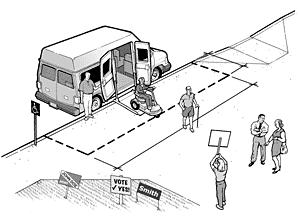
B3. Is the area for the access aisle at least 5-feet wide and 20-feet long? [ADA Stds 4.6.6] Note: Unlike an accessible parking space, the surface for the access aisle does not have to be marked or striped.
Yes _____ No _____
B4. Is the vertical height for the vehicle route to the loading zone, the drop off area, and the exit at least 114 inches (9 feet 6 inches) in height? [ADA Stds 4.6.5]
Yes _____ No _____
B5. Is a curb ramp provided between the vehicle pull up area and the access aisle (see figure above) or the access aisle and the accessible route (see figure on page 9) to the accessible entrance? [ADA Stds 4.6.6]
Yes _____ No _____
If No, is there another area with a curb ramp connected to an accessible route that could serve as the drop-off area?
Yes _____ No _____
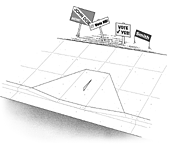
B6. If a curb ramp is provided, is the slope of the ramp surface (not counting the side flares) no more than 1:12?
[ADA Stds 4.7.2]
Yes _____ No _____
B7. Is the width of the curb ramp surface at least 36 inches?
[ADA Stds 4.7.3]
Yes _____ No _____
B8. Does an accessible route connect the curb ramp to the accessible entrance?
[ADA Stds 4.1.2(1)]
Temporary Solutions for Election Day
Passenger Drop-Off Areas
Problem:
A passenger drop-off and loading zone is provided but there is no curb ramp between the vehicle area and the sidewalk leading to the accessible polling place entrance.
Suggestion: Provide a portable ramp with edge protection in an area where the vehicle area and the sidewalk are relatively level. The curb ramp must connect to an accessible route to the accessible polling place entrance.
If the drop-off and loading zone is not relatively level, consider relocating the accessible drop-off area and using one parking space next to the area where accessible parking is located to provide an accessible drop-off and loading zone. Cones or another temporary barrier may be needed to keep the parking space clear.
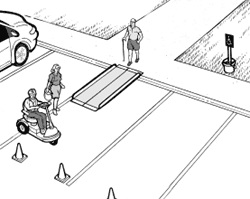
A portable ramp with edge protection is used to provide an accessible route from the drop-off and loading area to the accessible polling place entrance.
Part 1. Typical Issues for Voters Who Use Wheelchairs, Scooters or Other Mobility Aids
There must be at least one exterior accessible route that connects accessible passenger drop-off areas, accessible parking spaces, and other accessible elements, for example a route from a bus stop to an accessible building entrance. The accessible route is essential for people who have difficulty walking or who use wheelchairs or other mobility aids to get to the accessible entrance of the polling place.
An accessible route is at least 36 inches wide and may narrow briefly to 32 inches wide where utility poles, post-mounted signs, furniture, and doorways are located along an accessible route. Abrupt level changes, steps, or steeply sloped sidewalks cannot be part of an accessible route. Where ramps are used, they cannot be steeper than 1:12. Ramps with a vertical rise of more than 6 inches must have handrails on both sides. Ramps must also have edge protection to stop wheelchairs from falling off the sides, and level landings at the top and bottom of each segment and where a ramp changes direction.
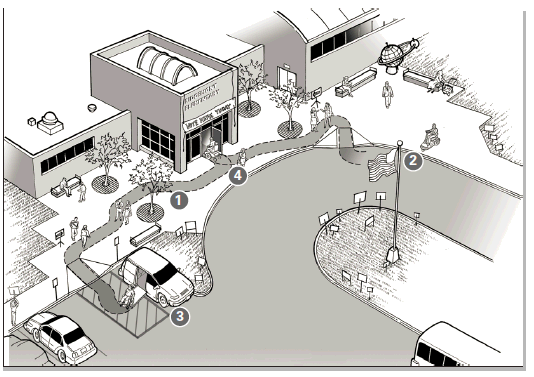
An accessible entrance to a polling place with accessible parking and an accessible drop-off area.
Notes:
1 Accessible route.
2. Accessible drop-off area.
3. Accessible parking with van accessible parking space.
4 Accessible entrance to polling place.
Sidewalks and Walkways Checklist - Voters with Mobility Disabilities
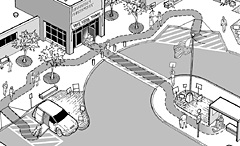
C1-1. Is an accessible route provided from accessible parking spaces to the accessible entrance of the building?
[ADA Stds 4.1.2(1), 4.3]
Yes _____ No _____
Note: If the accessible route crosses a vehicular route, a marked crosswalk should be used.
Yes _____ No _____
C1-2. Is an accessible route provided from public sidewalks and public transportation stops on the polling site (if provided) to the accessible entrance of the building? [ADA Stds 4.1.2(1)]
Yes _____ No _____
C1-3. Is the accessible route at least 36 inches wide?
If No, the accessible route may narrow to 32 inches wide for up to 2 feet in length.
Yes _____ No _____
C1-4. Is the accessible route free of steps and abrupt level changes over 1/2 inch?
Note: Level changes between 1/4 inch and 1/2 inch should be beveled.
Yes _____ No _____
C1-5. Where an accessible route crosses a curb is a curb ramp provided? If yes,
Yes _____ No _____
5a. Is the ramp surface at least 36 inches wide, excluding flared sides?
[ADA Stds 4.7.3]
Yes _____ No _____
5b. Is the slope (up or down the ramp) no more than 1:12? [ADA Stds 4.7.2]
Note: 1:12 is one inch of vertical height for 12 inches of horizontal distance.
Yes _____ No _____
C1-6. If the slope of part of the accessible route is greater than 1:20, does this part meet the following requirements for an accessible ramp?
Yes _____ No _____
6a. Is the ramp slope no greater than 1:12? [ADA Stds 4.8.2]
Note: For existing ramps, the slope may be 1:10 for a 6 inch rise and 1:8 for a 3 inch rise in special circumstances (see ADA Stds 4.1.6(3)).
Yes _____ No _____
6b. Is the ramp width, measured between handrails, at least 36 inches?
[ADA Stds 4.8.3]
Yes _____ No _____
6c. Does the ramp have a level landing at the top and bottom of each ramp section that is at least 60 inches long? [ADA Stds 4.8.4]
Note: The level landing may be part of the sidewalk or walking surface.
Yes _____ No _____
6d. If a ramp is more than 30 feet long, is a level landing at least 60 inches long provided every 30 feet of horizontal length? [ADA Stds 4.8.4]
Note: When the running slope is less than 1:16 and more than 1:20, each ramp segment may be up to 40 feet long followed by a level landing.
Yes _____ No _____
6e. Is a level landing, at least 60 inches by 60 inches, provided where a ramp changes direction? [ADA Stds 4.8.4]
Yes _____ No _____
6f. Are the handrails mounted between 34 and 38 inches above the ramp surface?
[ADA Stds 4.8.5]
Yes _____ No _____
6g. If the ramp or landing has a vertical drop-off on either side of the ramp, is edge protection provided? [ADA Stds 4.8.7]
Yes _____ No _____
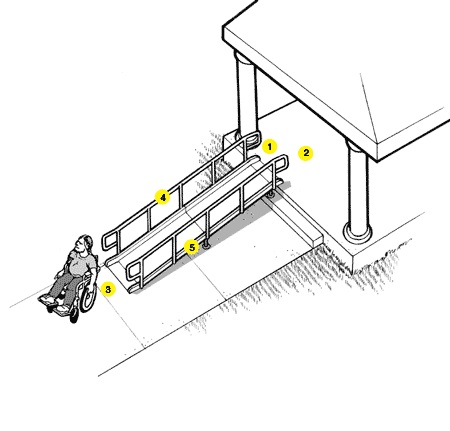
Accessible Ramp Features
1. At least 36 inches between handrails
2. Top landing part of walk
3. Bottom landing part of walk
4. Handrail height 34 to 38 inches
5. Edge protection
Temporary Solutions for Election Day
Sidewalks and Walkways - Voters with Mobility Disabilities
Problem One:
The sidewalk connecting parking to the polling place entrance is too steep to be accessible.
Suggestion: Check to see if there is another sidewalk that provides an accessible route to the accessible entrance. Sometimes there is a less direct route that can serve as the accessible route.
Problem Two:
The accessible route crosses a curb and no curb ramp is provided.
Suggestion: Install a portable ramp with edge protection.
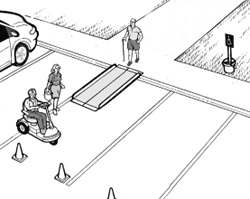
A portable ramp with edge protection is installed over a curb to provide an accessible route.
Problem Three:
One or two steps are part of the walkway leading to the accessible entrance.
Suggestion: Install a portable ramp no steeper than 1:12 slope with edge protection and handrails
Part 2. Typical Issues for Voters Who Are Blind or Have Low Vision
Objects that are wall-mounted, that project into a pedestrian route from the side, or that are overhead must be located so that people who are blind or who have low vision will either detect the objects before they run into them or safely pass under them. Examples include handrail extensions on stairs and ramps, post or wall-mounted signs, outdoor drinking fountains, and tree limbs that are lower than 80 inches above the walk. Pedestrian routes open to voters, such as sidewalks, courtyards, and plazas, must be free of overhanging objects that are less than 80 inches above the route. Objects more than 27 inches and less than 80 inches above the route that protrude from the side more than 4 inches are also a hazard. Because people can walk on any sidewalk, not just the accessible routes, all exterior pedestrian routes serving or leading to the voting area must be checked. The following checklist applies to sidewalks and walkways leading to the polling place and voting area.
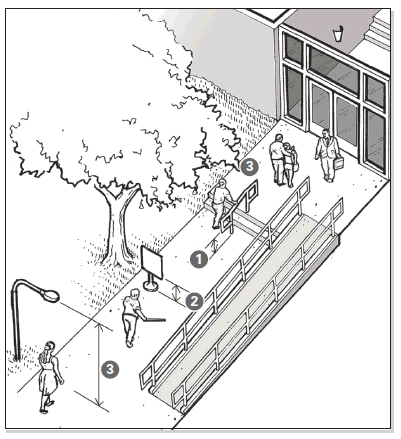
Common objects along pedestrian routes to a polling place that can be hazards to people who are blind or have low vision.
Notes:
1. The bottom of the handrail extensions turn down so a person who is blind or has low vision can detect the hazard before running into it.
2. Signs or other objects in the pedestrian route can be a hazard if the bottom is more than 27 inches but less than 80 inches above the route.
3. Objects that overhang the pedestrian route must be at least 80 inches above the route.
C2-1. Are all sidewalks and walkways to the voting area free of any objects (e.g., wall-mounted boxes, signs, handrail extensions, trees) with bottom edges that are higher than 27 inches but less than 80 inches above the walkway and that extend more than 4 inches into the sidewalk or walkway? [ADA Stds 4.4, 4.2.1(3), 4.1.3(2)]
Yes _____ No _____
If No, can the object be lowered, removed, or modified or can the route be changed to avoid the object?
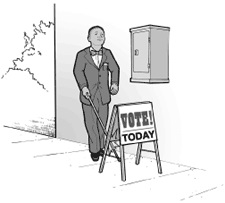
This wall-mounted box is mounted too high to be detectable by a person who is blind. Placing an object, like this sign, under the box provides a way to warn the person before they walk into the side of the box.
C2-2. Are the undersides of exterior stairs enclosed or protected with a cane detectable barrier so that people who are blind or have low vision will not hit their heads on the underside?
[ADA Stds 4.4.2]
Yes _____ No _____
If No, can a barrier or enclosure be added below the stair or can the route be relocated away from the stair?
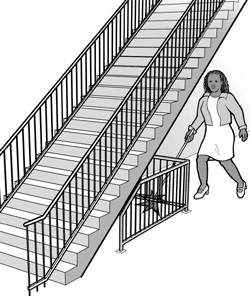
When the underside of a stair is open, it is a hazard to people who are blind or have low vision. Enclosing the area below the stair or installing a cane-detectable barrier helps the person to stop before hitting her head.
C2-3. Are all objects that hang over the pedestrian routes 80 inches or more above the route?
If No, can the objects be removed or relocated, or can a detectable object be added below?
Yes _____ No _____
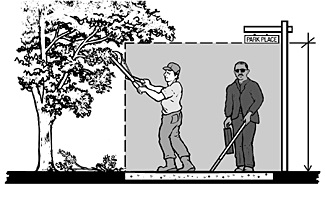
At least 80 inches above walk
Temporary Solutions for Election Day
Sidewalks and Walkway Hazards
Problem One: Branches or other objects over a walkway or pedestrian route are lower than 80 inches above the walk.
Suggestion: Prune the branches or remove the items that are hanging below 80 inches. Another approach is to install a detectable barrier under the item that is too low. The detectable barrier or object must be within the detectable range of 27 inches or less above the route.
Problem Two: One or more objects protrude too far from the side into the circulation path causing a hazard for people who are blind or who have low vision.
Suggestion: When people who are blind or who have low vision use a cane to detect hazards, objects located at 27 inches or lower are detectable. When an object is located more than 27 inches off the ground it is a hazard if the object protrudes more than 4 inches into the circulation path. To make a protruding object detectable:
Place an object or a barrier below the protruding object in the cane-detectable area not more than 27 inches above the floor.
If the protruding object can be moved, lower the object so its bottom is within the cane-detectable area (not more than 27 inches above the floor).
Prune or alter the protruding object so it does not protrude over the path.

User Comments/Questions
Add Comment/Question